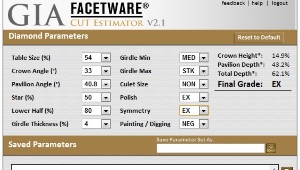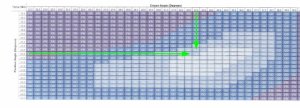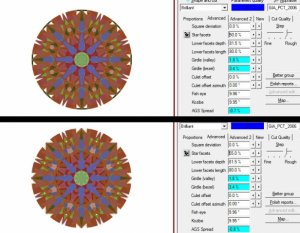- Joined
- Aug 14, 2009
- Messages
- 27,502
I've found in my time here that there's been a clear progression in what I think is the best way to choose a stone that hasn't/can't be reviewed by a trusted professional. I went from "trust your eyes" to "it's all about the tools and numbers" to "well, numbers don't tell you everything, but photos are generally good enough" to "I'm withholding all judgment until I see the thing in-person". Meaning that I'm right back where I started - I'll trust my eyes. Now my eyes have a much better idea of what to look for, so I'm confident that trusting them won't lead me astray.
2023/Titan - I agree that HCA can be too harsh on steeper pav stones - hence my personal rec for cutoff at 3 or 3.5 for "worth getting more info on", which is all that HCA is designed to tell you. I also agree that it is useless to quibble over a 0.1 or 0.2deg difference as presented on the report, after measurements have been averaged and rounded, knowing that the scanners the labs use are only accurate to 0.1deg (and from the sarin website I have absolutely no idea if that's w/ a 95% confidence or 99 or...)
The followup blurb is interesting. There are definitely different sorts of "overly deep" - DiaGem I believe stated that slight leakage under the table can yield more fire in various types of lights, and I've seen BS printouts on GOG that confirm that (yes, I know, BS is a whole different topic). It is a logical conclusion - white light is always going to be higher energy, it'll drown out proximal dispersions. Then we get into stone size, and from there into facet size - larger facets spaced further apart angled further away from each other are going to permit more visible coloured light return...
I think this article from Karl is really helpful w/ putting things in perspective. The LGF perspective specifically HCA doesn't consider LGF at all, and it can make a big difference in how a stone looks https://www.pricescope.com/journal/do_pavilion_mains_drive_light_return_modern_round_brilliant
HCA doesn't consider LGF at all, and it can make a big difference in how a stone looks https://www.pricescope.com/journal/do_pavilion_mains_drive_light_return_modern_round_brilliant
I love seeing colour, so I've got no problem with some leakage under the table, if it's because of shorter lower halves. That isn't want most people who come to PS are looking for though. Since I love colour I'm also much more forgiving of deep high-crown stones than I am of low-crown/deep pav stones - so 36/41 would go into my personal "get more info on" bucket. But again, that isn't what most people who come to PS are looking for. I don't like painted stones, the folks at EightStar make a living off the practice, and most newbies don't care either way.
Hmm. Not sure what the point of that post was... well, maybe it'll give someone somewhere something to chew on.
2023/Titan - I agree that HCA can be too harsh on steeper pav stones - hence my personal rec for cutoff at 3 or 3.5 for "worth getting more info on", which is all that HCA is designed to tell you. I also agree that it is useless to quibble over a 0.1 or 0.2deg difference as presented on the report, after measurements have been averaged and rounded, knowing that the scanners the labs use are only accurate to 0.1deg (and from the sarin website I have absolutely no idea if that's w/ a 95% confidence or 99 or...)
The followup blurb is interesting. There are definitely different sorts of "overly deep" - DiaGem I believe stated that slight leakage under the table can yield more fire in various types of lights, and I've seen BS printouts on GOG that confirm that (yes, I know, BS is a whole different topic). It is a logical conclusion - white light is always going to be higher energy, it'll drown out proximal dispersions. Then we get into stone size, and from there into facet size - larger facets spaced further apart angled further away from each other are going to permit more visible coloured light return...
I think this article from Karl is really helpful w/ putting things in perspective. The LGF perspective specifically
I love seeing colour, so I've got no problem with some leakage under the table, if it's because of shorter lower halves. That isn't want most people who come to PS are looking for though. Since I love colour I'm also much more forgiving of deep high-crown stones than I am of low-crown/deep pav stones - so 36/41 would go into my personal "get more info on" bucket. But again, that isn't what most people who come to PS are looking for. I don't like painted stones, the folks at EightStar make a living off the practice, and most newbies don't care either way.
Hmm. Not sure what the point of that post was... well, maybe it'll give someone somewhere something to chew on.






300x240.png)